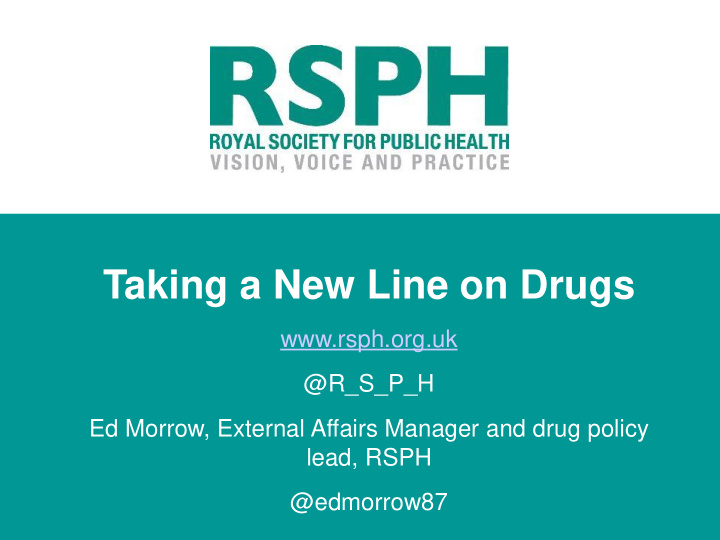



Taking a New Line on Drugs www.rsph.org.uk @R_S_P_H Ed Morrow, External Affairs Manager and drug policy lead, RSPH @edmorrow87
About RSPH ➢ World’s longest -established public health body (160 years) ➢ Independent health education charity dedicated to protecting and promoting the public’s health and wellbeing ➢ More than 6,000 members in the UK and internationally ➢ Provide qualifications, training and accreditation, peer- reviewed journals, policy and campaigns
Our vision “Everyone has the opportunity to optimise their health and wellbeing”
RSPH and drug policy ➢ TANLOD: June 2016 ➢ Why get involved? – Harm rising even as use falls – Absence of public health voice speaking out on the issue – Clear health inequalities issue – Set out fundamental principles of a public health approach to drugs policy (not a complete solution)
(Illegal) drug use in the UK England and Wales stats (NHS Digital 2017)
(Illegal) drug harm in the UK Deaths related to drug misuse Hospital admissions for drug- related mental/ behavioural disorders
(Illegal) drug harm in the UK ➢ There were 3,744 drug poisoning deaths involving both legal and illegal drugs registered in England and Wales in 2016 (65 per million population), the highest number since comparable records began in 1993. ➢ More than half (54%) of all deaths related to drug poisoning in 2016 involved an opiate (mainly heroin and/or morphine). ➢ The UK drug death rate is almost three times higher than the European average. ➢ Almost one in three drug overdoses in Europe are recorded in the UK.
The current response 'New' Drug Strategy 2017 – reduce demand, restrict ➢ supply, build recovery Criminalisation: ➢ – does not prevent use (international evidence and domestic experience is clear) – is a barrier to treatment access – causes additional harm through unsafe usage and damage of criminal record or imprisonment – exacerbates health inequalities, especially racial Confusing classification system not tied to evidence- ➢ based assessment of harm, hampers credibility and public health messaging Inadequate funding and service provision ➢
Alternative responses Portugal (decrim. 2001): ➢ New cases of HIV among PWID down from 1,016 to 56 ➢ Deaths down from 80 to 16 ➢ Problem drug use down in 15-24 year olds ➢ Overall levels of drug use below European average
The new lines 1) Closely aligned, health-led strategies: Transfer lead responsibility to the Department of Health 2) Prevention through universal education: Introduce comprehensive, statutory PSHE in schools 3) Beyond legal classification: Inform strategies and public health messaging using evidence-based drug harm profiles 4) Decriminalising drug users: The evidence relating to any potential health benefits or harm from legal, regulated supply should be kept under review 5) Supporting individuals to reduce and recover from harm: Exploit the potential of the wider public health workforce to support drug users into treatment services
Prospects for change Strong press support ➢ Medical, PH and law enforcement ➢ establishment increasingly vocal More than half the public (56%) ➢ agree drug users in their area should be referred to treatment, rather than charged with a criminal offence. Less than a quarter (23%) disagree. UK political establishment lagging ➢ behind the zeitgeist On-the-ground harm reduction – ➢ drug safety testing, supervised injection facilities
Drug safety testing ➢ Deaths related to ecstasy use in England and Wales have risen from 10 in 2010 to 57 in 2015 ➢ Drug safety testing pilots at two UK festivals in 2016 saw almost one in five users (18%) dispose of their drugs once aware of the content ➢ Mounting anecdotal evidence of decreased presentations to medical/welfare services where testing present
Thank you @edmorrow87 @R_S_P_H #TANLOD www.rsph.org.uk
Recommend
More recommend